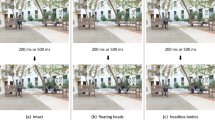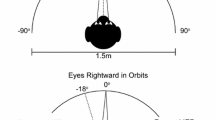Abstract
The study of active vision using binocular head-eye systems requires answers to some fundamental questions in control of attention. This paper presents a cooperative solution to resolve the ambiguities generated by the processes engaged in fixation. We suggest an approach based on integration of these processes, resulting in cooperatively extracted unique solutions.
The discussion is started by a look at biological vision. Based on this discussion, a model of integration for machine vision is suggested. The implementation of the model on the KTH-head—a head-eye system simulating the essential degrees of freedom in mammalians—is explained and in this context, the primary processes in the head-eye system are briefly described. The major stress is put on the idea that the rivalry processes in vision in general, and the head's behavioral processes in particular, result in a reliable outcome.
As an experiment, the ambiguities raised by fixation at repetitive patterns is tested; the cooperative approach proves to handle the problem correctly and find a unique solution for the fixation point dynamically and in real-time.
Chapter PDF
Similar content being viewed by others
Keywords
These keywords were added by machine and not by the authors. This process is experimental and the keywords may be updated as the learning algorithm improves.
References
M. A. Ali, M. A. Klyne. Vision in Vertebrates, Plenum Press, New York, 1985
S. T. Barnard, M. A. Fischler Computational and Biological Models of Stereo Vision, to appear in the Wiley Encyclopedia of Artificial Intelligence (2nd edition), 1991
C. Brown. The Rochester Robot, Tech. Rep., Univ. of Rochester, 1988
J. J. Clark, N. J. Ferrier. Modal Control of an Attentive Vision System, Proc. of the 2nd ICCV, Tarpon, Springs, Fl, 1988
H. Collewijn. Binocular Coordination of Saccadic Gaze Shifts: Plasticity in Time and Space, Sixth European Conference on Eye Movements, Leuven, Belgium, 1991
R. Deriche, O. Faugeras. Tracking Line Segments, Proc. of the 1st ECCV, Antibes, France, 1988
V. R. Galoyan Hydrobiomechanical Model of Eye Placing and Movements, Sixth European Conference on Eye Movements, Leuven, Belgium, 1991
D. H. Hubel. Eye, Brain, and Vision, Scientific American Library, 1988
M. R. M. Jenkin Using Stereo Motion to Track Binocular Targets, Proc. of CVPR, Lahainz, Hawaii, 1991
B. Julesz. Fundations of Cyclopean Perception, The University of Chicago Press, 1971
E. P. Krotkov. Exploratory Visual Sensing for Determinig Spatial Layout with an Agile Stereo System, PhD thesis, 1987
K. Pahlavan, J. O. Eklundh. A Head-Eye System for Active, Purposive Computer Vision, TRITA-NA-P9031, KTH, Stockholm, Sweden, 1990
K. Pahlavan, J. O. Eklundh. Head, Eyes and Head-Eye Systems, SPIE Machine and Robotics Conference, Florida, 1992 (To appear)
A. Yarbus. Eye Movements and Vision, Plenum Press, New York, 1967
Author information
Authors and Affiliations
Editor information
Rights and permissions
Copyright information
© 1992 Springer-Verlag Berlin Heidelberg
About this paper
Cite this paper
Pahlavan, K., Uhlin, T., Eklundh, JO. (1992). Integrating primary ocular processes. In: Sandini, G. (eds) Computer Vision — ECCV'92. ECCV 1992. Lecture Notes in Computer Science, vol 588. Springer, Berlin, Heidelberg. https://doi.org/10.1007/3-540-55426-2_58
Download citation
DOI: https://doi.org/10.1007/3-540-55426-2_58
Published:
Publisher Name: Springer, Berlin, Heidelberg
Print ISBN: 978-3-540-55426-4
Online ISBN: 978-3-540-47069-4
eBook Packages: Springer Book Archive




